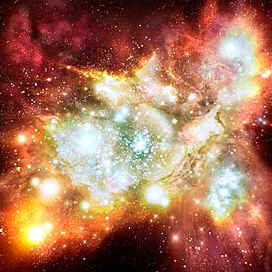|
Word Gems
exploring self-realization, sacred personhood, and full humanity
Light
Dr. Gerald L. Schroeder
return to 'Light' main-page
"...no one yet suspected that the flow of time could be related to the flow of light." Dr. Gerald L. Schroeder

The "Lynx Arc" is 1 million times brighter than the well-known Orion Nebula. It is the biggest, brightest, and hottest star-forming region ever seen in space, 12 billion light-years from Earth.
Dr. Gerald L. Schroeder, M.I.T. nuclear physicist and Hebrew scholar, Genesis and the Big Bang and The Science of God:
- "Kepler's observation was the first indication that radiant energy, such as light, which had always been assumed to be substanceless, might also have a mass or weight."
- "In 1864... James Clerk Maxwell postulated that light and all other electromagnetic radiation moved as waves at the same fixed speed through space. [Visible light, microwaves, X rays, gamma rays] are all composed of electromagnetic radiation. The only difference among them is their wavelength and frequency of the wave. The higher the energy of the radiation, the shorter its wavelength and the higher its frequency. Aside from this they are identical."
- "Prior to [Einstein's] relativity, time was always considered to be absolute. Regardless of who measured the duration of an event, the elapsed time was thought to be the same. Some 300 years ago, Newton stated this belief eloquently: 'Absolute, true and mathematical time, of itself, and from its own nature, flows equably without relation to anything external.'"
- "... time and space were thought to be unconnected -- one did not influence the other. After all, what other connection could there be between the distance separating two points and the flow of time other than the fact that a greater distance requires a longer time to traverse: pure and simple logic."
- "In 1900 Max Planck proposed a description of electromagnetic radiation that was a radical departure... [It had been] assumed that the energy radiated by a warm object, such as the warming glow of a red-hot iron, was released in a smooth continuous process... But Planck observed that just the opposite was true. Instead of being a smooth, continuous flow, the energy was released in discrete units, as if a glowing iron gave off its heat by shooting out a rapid stream of tiny hot pellets. Planck theorized that these pellets were actually the radiant energy. He called these pellets quanta, and thus quantum mechanics was born. Because all radiation moved at the same speed (the speed of light), the quanta must do likewise... [but] they might not all have equal energies. The energy of an individual quantum, he proposed, was proportional to its frequency of vibration as it sped through space. In the visible range, our eyes can measure the frequency at which the quanta pulse [which measure is] the color of the light. It is because of this quantized release of energy that an object , when gently heated, first glows red, then, as its temperature rises, emits additional colors, going through the rainbow spectrum of increasing energy and frequency..."
- "Here lies a paradox -- the very theory that described light as being composed of particles [quanta], also described the same energy in terms of frequencies. But frequencies are associated with waves not particles. Furthermore, the speed of light was always to be constant. But what would happen if the object emitting the light or the subject observing the light were moving? Would the speed of their motion add to or subtract from the speed of the light? Logically, it must but then the speed of light would not appear to be constant!"
- "The pressure light exerts [when it strikes a surface such as a mirror] implies a change in momentum of the light as it crashes to a stop on striking a surface. This is the source of pressure from any moving object. The spray of water from a hose pushes a ball along the ground because the water has mass and this mass has a velocity that is stopped when the water hits the ball. In stopping, the water transfers its momentum to the ball and the ball rolls away. The very definition of momentum -- mass (m) of an object times its velocity (v), or mv -- requires that the moving light have a mass. Somehow these wavelike particles of light had a mass associated with them, even though there was no material residue of this mess left on the surface on which a light was shining. There was no mess to wipe up after a light spilled onto a surface."
- "...no one yet suspected that the flow of time could be related to the flow of light... In 1887, Albert Michelson and Edward Morley published ... [that] there is no effect of the Earth's motion on the speed of light. This was very confusing. We have a speed of light (c) that is constant whether or not the source of the light or the observer of the light is moving."
- "In 1905... Using Planck's theory, Einstein was able to explain an interesting phenomenon. Light shining on certain metals releases electrons and in so doing creates the potential for the flow of electric current. [He] postulated that this 'photelectric' effect was the resuslt of quanta of light [photons] literally knocking electrons out of their orbits. The photon, it turns out, has mass while in motion (recall that it moves with the velocity of light, c), but has no mass when stopped (zero rest mass)."
- "Matter and energy seemed to be intimately connected in the photon. Einstein discovered this relation and described it in his now-famous formula: E = mc2. The energy of a photon, E, equals its mass, m (while in motion), times the speed of light squared, c2 ... this relation was applicable to all masses and all forms of energy. It is the basis of the special theory of relativity."
|
